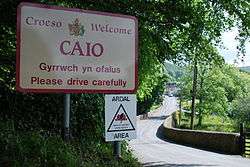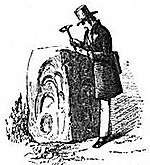Caio, Carmarthenshire
Caio or Caeo is a village in the county of Carmarthenshire, south-west Wales, sited near to the Dolaucothi Gold Mines.
Caio Caeo | |
|---|---|
Village | |
 Caio | |
| Coordinates: | |
| Country | United Kingdom |
| County | Carmarthenshire |
| Parish | Cynwyl Gaeo |
Location
It is located between Llandovery and Lampeter, 1 mile (1.6 kilometres) north-east of the A482 that connects these two towns. Caio lies at the confluence of the Afon Annell and the Nant Frena. It forms part of the parish of Cynwyl Gaeo.[1] In former times it gave its name to Cayo Hundred.
History

The parish church, consecrated to Saint Cynwyl, now stands at the centre of the village, near the Roman road that linked the Roman forts at Llandovery (Alabum) and Llanio (Bremia), and the Roman gold mines at Dolaucothi. The Roman road remained in use until the late 18th century, mainly as a cattle-road or Drover's road. The Dolaucothi Estate long held by the Johnes family is now a tourist attraction owned by the National Trust. A pounding-stone long known as Carreg Pumsaint[2] and a possible holy well are located nearby.
Llywelyn ap Gruffydd Fychan (c. 1341 – 9 October 1401) was a Caio landowner, who was executed by Henry IV for his allegiance to Owain Glyndŵr. The hymnist Dafydd Jones (1711–1777), also known as Dafydd Jones o Gaeo was born in the area. Two other hymnists, the brothers John Dafydd (1727–1783) and Morgan Dafydd (m. 1762) are also connected to the village.
The oldest record of a chapel in the village is the Tynewydd Calvinistic Methodists chapel which was built around 1774.[1] The old Ysgol Gynradd Caio stands next to the church, and was built in 1869. It taught primarily through the medium of Welsh, but closed in 2012.
Wales rugby union football international, later clergyman, John Strand-Jones (1877–1958) was born in Caio, and Victoria Cross recipient James Hills-Johnes (1833–1919) is buried here.
Amenities
Other amenities include Caio Post Office (closed in the 1990s) and a public house, the Brunant Arms. At the turn of the 20th century there were several public houses, the "Brunant Arms", the "Sexton's Arms", which was run out of someone's front room,[3] and the "King's Head Inn".[4]
In 1966 BBC Wales produced the documentary "A Village Called Caio" about rural life in rural West Wales. They paid a retrospective visit in 2008,[5] to see how the village had changed.
See also
References
- Gareth Hicks (4 June 2009). "CONWIL CAIO [CYNWYL GAEO]". GENUKI. Retrieved 16 January 2011.
- "Carreg Pumsaint - Standing Stone (Menhir) in Wales in Carmarthenshire (Sir Caerfyrddin)". The Megalithic Portal.
- "Henry Tremble". Stories in Welsh Stone. 20 April 2009. Archived from the original on 7 March 2009.
- Fred S. PRICE (1904). "History of Caio, Carmarthenshire". Archive.org.
- "Time May Change Me - A Village Called Caio". BBC. Retrieved 20 December 2011.